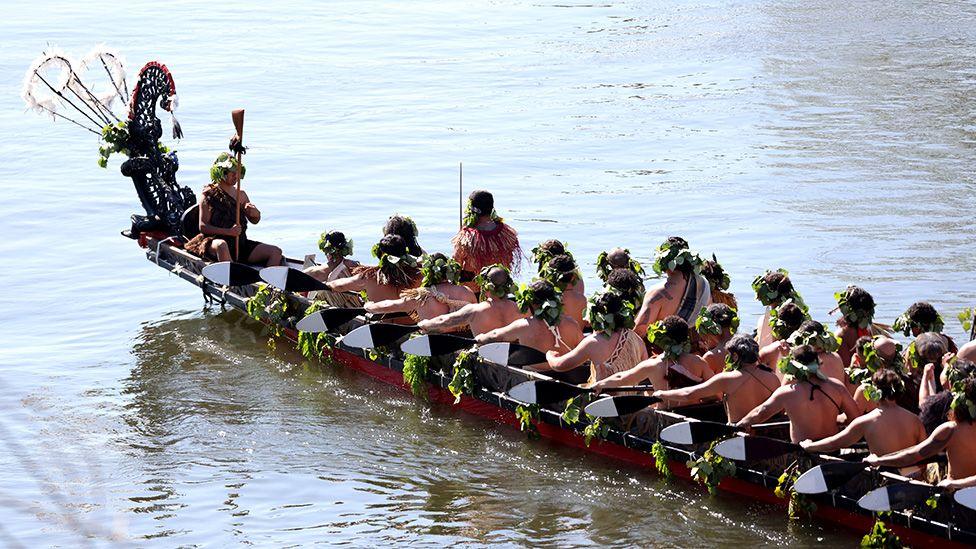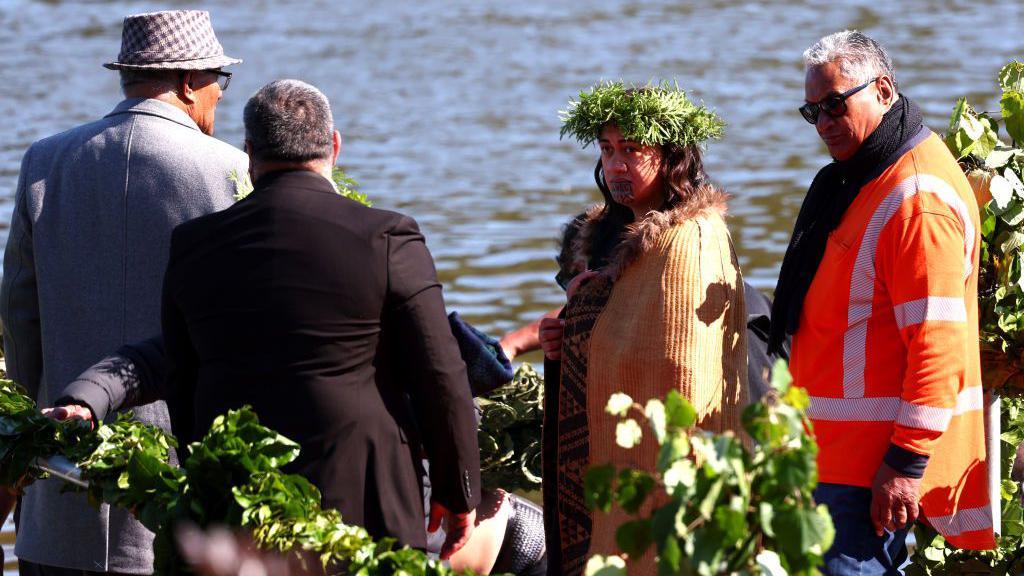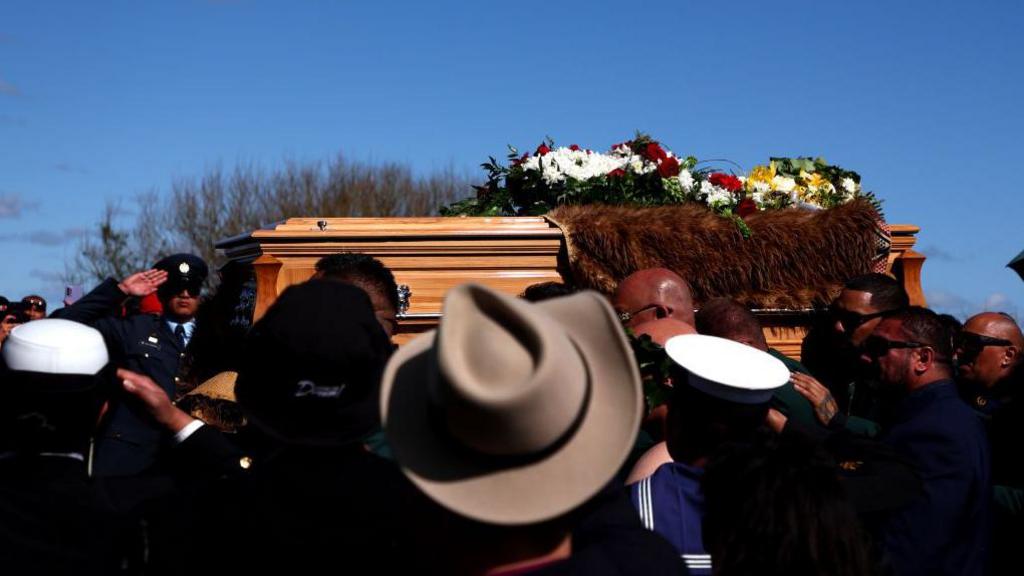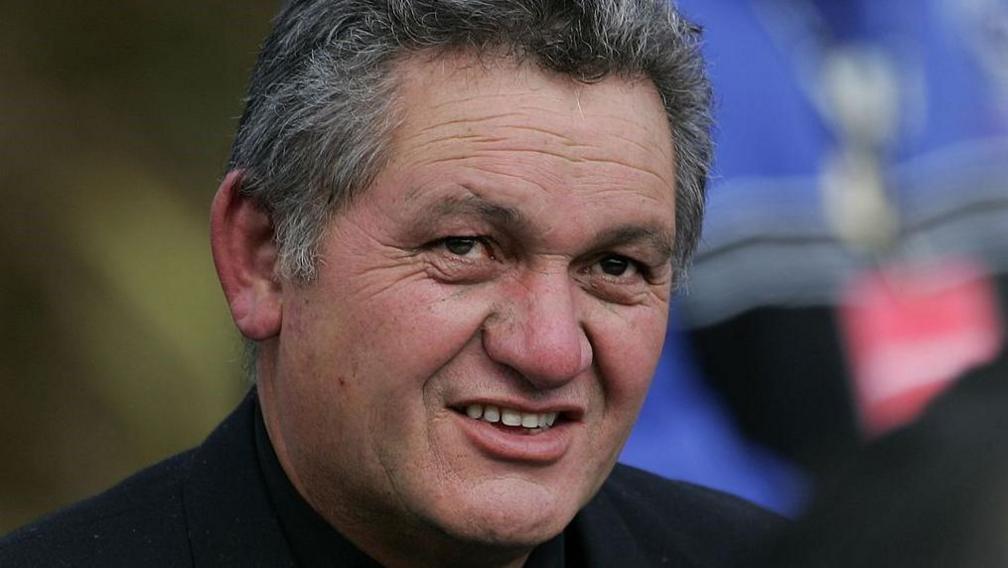New Māori queen crowned as her father is buried
Watch: New Māori queen crowned as her father King Tuheitia is buried
- Published
A new queen was crowned as the eighth Māori monarch in New Zealand as her father, Kiingi Tuheitia Pōtatau Te Wherowhero VII, was laid to rest.
Twenty-seven-year-old Ngā Wai hono i te pō was chosen as kuini - the Māori word for queen - by a council of New Zealand's indigenous Māori chiefs during an elaborate ceremony in the country's North Island.
She is only the second Māori queen, the first being her grandmother, Te Arikinui Dame Te Atairangikaahu.
Ngā Wai hono i te pō is the youngest child of Kiingi Tuheitia, who died last Friday at the age of 69.

The ceremony ended a week of mourning, extended from the usual three days to accommodate all who came to pay tribute
Sitting on a carved wooden throne, the new queen was announced at a gathering at Tūrangawaewae Marae, which is the seat of the Kiingitanga or Māori king movement.
She was blessed with the same Bible that was used to anoint the first Māori king in 1858 and sat in front of her father's coffin, wearing a wreath and a cloak as prayers and chants were performed ahead of his burial.
A flotilla of carved war canoes, or waka, then transported the king to his final resting place on Mount Taupiri, sacred to the Māori people.
The king had been recovering from heart surgery in hospital when he died, just days after celebrating the 18th anniversary of his coronation.
The naming of Ngā Wai hono i te pō as queen marks a generational shift. Many also see it as a gesture of renewal and a positive influence on younger Māori members.
The new queen holds a masters degree in Māori cultural studies and teaches kapa haka, the Māori term for performing arts.
A haka dance accompanied some of Kiingi Tuheitia's funeral ceremony, which was elaborate and in many parts emotional. His coffin was then taken by a flotilla of waka along the Waikato River before being carried up Mount Taupiri, where he was laid to rest.
The ceremony marked the end of a week of formal proceedings following Kiingi Tuheitia's death.

Ngā Wai hono i te pō, 27, is only the second Māori queen.
"The death of Kiingi Tuheitia is a moment of great sadness for followers of Te Kiingitanga, Maaoridom and the entire nation," Rahui Papa, spokesman for the Kiingitanga or Māori king movement, said at the time of Kiingi Tuheiti's death.
"A chief who has passed to the great beyond. Rest in love."
“Our country will be in mourning,” said Chris Hipkins, leader of New Zealand’s opposition Labour party, shortly after the king's death. “He was a fantastic king with a wicked sense of humour, but also a very good man… with a real focus on bringing New Zealanders together.”
New Zealand’s prime minister Christoper Luxon praised King Tuheitia as a leader "whose commitment to Māori and all New Zealanders has been felt right across the country".
However, Mr Luxon – whose government's policies have been accused by some New Zealanders as being anti-Māori – is on an official trip to South Korea and did not attend the funeral.
Last year, thousands of protesters across New Zealand rallied against the government's plans to reverse policies which boosted Indigenous rights. These included plans to close the Māori Health Authority, Te Aka Whai Ora, which was set up during Jacinda Ardern's government, and plans to switch the names of some departments from Māori to English.

Kiingi Tuheitia's coffin was carried from his waka up Mount Taupiri, where he was laid to rest.
Kiingi Tuheitia’s official period of mourning was extended from the usual three days to seven days in order to accommodate the huge delegations that came to pay tribute to him.
"I have never experienced anything like this," Mereana Hond, a Māori journalist, told BBC Newsday.
"We have lost a king who was rising in prominence, leading all tribes of Aotearoa/New Zealand at a time when we're under a lot of political and social pressure under this coalition government."
Kiingi Tuheitia was born Tūheitia Paki in 1955, and crowned in 2006 following the death of his mother, Te Arikinui Dame Te Atairangikaahu. Like his mother, he was seen as a great unifying figure, recently calling on Māori to stand together in the face of policies targeting them.
The Māori monarchy dates back to the 19th Century, when different Māori tribes decided to create a unifying figure similar to that of a European monarch in order to try to prevent the widespread loss of land to New Zealand's British colonisers and to preserve Māori culture. The role is largely ceremonial.
Related topics
- Published30 August 2024

- Published30 May 2024

- Published5 December 2023
